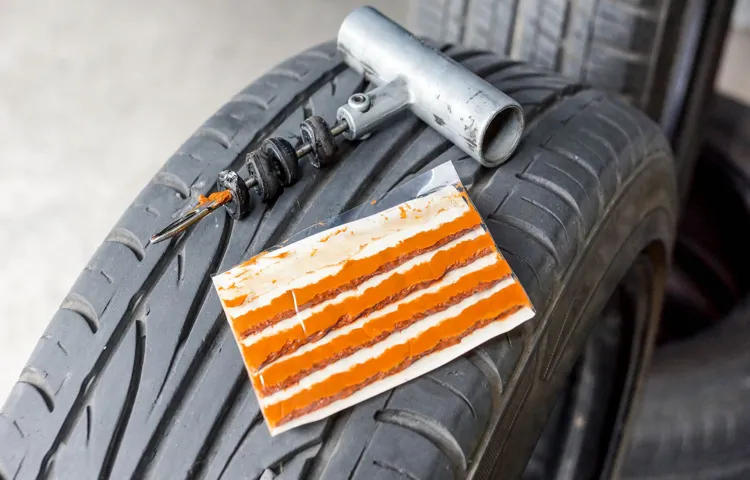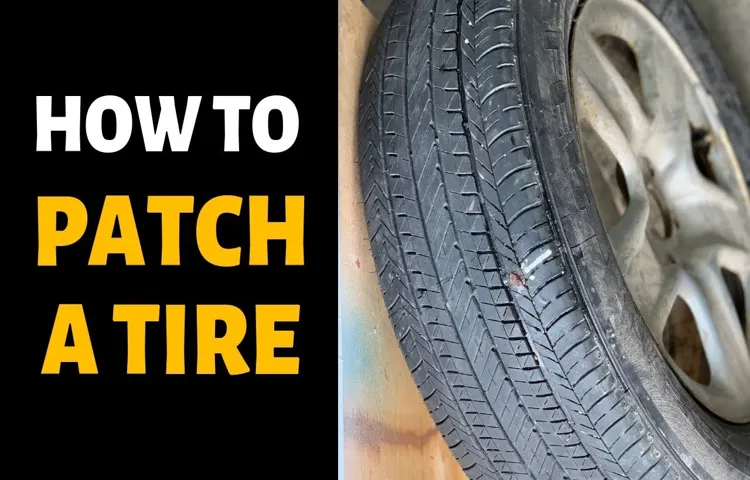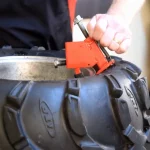Have you ever wondered how many times you can patch a flat tire before buying a new one? It’s a common question that many drivers ask, especially those who rely on their car for daily commutes. The truth is, there is no set number of times a tire can be patched, as it depends on various factors such as the size and location of the puncture, as well as the age and condition of the tire itself. Think of a tire as a piece of cloth that has been repeatedly sewn.
Just like how the more you sew a piece of cloth, the weaker it becomes over time, the same concept applies to a tire that has been patched multiple times. Each patch weakens the tire’s structure, increasing the risk of another puncture or even a blowout. That being said, a tire can be patched multiple times if the puncture is small and located on the tread area, away from the sidewalls.
However, if the puncture is too large or located in a critical area of the tire, it may be impossible to repair it safely, and a new tire would be necessary. In conclusion, while it is possible to patch a tire multiple times, it is essential to assess the location and size of the puncture, as well as the overall condition of the tire, before making a decision. It’s always better to err on the side of caution and replace the tire if necessary to ensure your safety on the road.
Table of Contents
Introduction
If you are wondering how many times a tire can be patched, the answer is not straightforward. Safety is the biggest concern when it comes to tire repairs, and the decision to patch a tire depends on its size, location of the puncture, and previous repair history. Generally, it is recommended not to patch a tire more than three times as it compromises the structural integrity of the tire.
Moreover, it also depends on the kind of tire you have and the quality of the patching job done each time. Therefore, it is best to consult a professional tire technician who can assess the tire’s condition and advise you on whether it’s safe to patch or replace the tire. Safety should always be the top priority when it comes to tire maintenance.
Regular checkups are necessary to ensure the tires’ safety and reliability, especially if you do a lot of driving or if your tires have been repaired before. Remember, a tire is the only point of contact between your vehicle and the road, so it’s essential to maintain it meticulously.
What is a Tire Patch?
Have you ever had a flat tire while driving? It’s not a fun experience and can leave you stranded on the side of the road. Fortunately, tire patches offer a solution to this problem. A tire patch is a piece of rubber that is used to repair a punctured tire.
It is applied to the inside of the tire, covering the hole and creating a seal that prevents air from escaping. This allows the tire to be inflated and used again, without the need for a full replacement. Tire patches are a cost-effective and efficient way to fix a flat tire quickly, but it’s important to note that they are only suitable for certain types of punctures and cannot be used as a permanent fix.
If you’re unsure about the integrity of your tire, it’s always best to consult a professional mechanic.

Why Patch a Tire?
patch a tire Introduction: There are many reasons why you may need to patch a tire. Maybe there’s a slow leak or a puncture that needs to be fixed, or you want to save money by avoiding tire replacement. Whatever the case may be, patching your tire can extend its lifespan and ensure that you’re driving safely on the road.
But why is patching a tire so important, and what are the benefits of doing so? In this blog post, we’ll explore the various reasons why it’s crucial to patch a tire, what you need to know before tackling the job, and some tips on how to do it yourself. One of the main reasons to patch a tire is to ensure that it’s safe to drive on. When a tire is punctured or has a slow leak, it can become unstable and increase the risk of an accident.
The last thing you want is to get a blowout while you’re driving down the highway. Patching the tire can help to maintain its structural integrity and prevent further damage. Additionally, patching your tire can save you money in the long run.
Instead of having to replace the entire tire, you can fix the issue for a fraction of the cost. This is especially beneficial if your tire is relatively new or is still in good condition otherwise. Lastly, patching a tire is an environmentally-friendly option.
By repairing your tire instead of throwing it away, you’re helping to reduce waste and conserve resources. Overall, patching a tire is a smart choice that can extend the lifespan of your tire, keep you safe on the road, save you money, and benefit the environment.
Factors Affecting the Number of Tire Patches
Tire patches are essential in maintaining the performance and longevity of your vehicle’s tires. However, the number of patches required can be influenced by several factors. One of the primary determinants of the number of tire patches needed is the extent of damage to the tire.
If you drive your vehicle on rough terrain or encounter sharp objects like nails or rocks on the road, the likelihood of tire punctures increases, leading to additional patches. Other factors that affect the number of tire patches needed include the speed and distance driven, as well as the quality of the tire. Higher speeds and longer distances put more strain on your tires and increase the risk of damage, leading to more patches.
Additionally, opting for lower quality tires may save you money upfront, but they are more prone to punctures and wear out quicker, necessitating more tire patches. Ultimately, proper tire maintenance, including regular checks for wear and tear, can help prevent the need for excessive patches, ultimately saving you money and ensuring your safety on the road.
How Many Times Can a Tire be Patched?
If you’re wondering how many times a tire can be patched, the answer is that it depends on the tire’s size, age, wear and tear, and the size and location of the puncture. Generally, a tire can be repaired multiple times if the puncture is small and on the tread, away from the sidewall. However, if the tire has been repaired multiple times, or if the puncture is too close to the sidewall, the tire might not be safe to use anymore, as it can increase the risk of a blowout or tread separation.
In these cases, it is best to replace the tire to ensure the safety of the driver and passengers. It is also important to follow the manufacturer’s recommendations and guidelines for tire repair and maintenance, as they can vary depending on the type, size, and use of the tire.
Manufacturer’s Recommendation
According to the manufacturer’s recommendations, a tire can be patched a maximum of three times. However, this limit only applies to small punctures that are no more than a quarter inch in diameter, and the patches used should be of high quality and installed properly. It’s important to note that not all punctures can be patched and that some damage may require the tire to be replaced entirely.
Additionally, it’s crucial to have a professional inspect the tire before repairing it and to only use a patch that is designed specifically for that tire’s type and size. So, if you notice a puncture in your tire, have it inspected promptly by a qualified technician to determine the best course of action. Remember, your safety is important, and driving on a damaged tire puts you and other drivers at risk on the road.
Industry Standards
When it comes to tire safety, there are various industry standards that motorists need to keep in mind. One of the most commonly asked questions is how many times can a tire be patched? According to the Rubber Manufacturers Association (RMA), a tire can usually be repaired up to three times, depending on the location of the puncture and the repairs that have already been made. It’s essential to remember that each repair reduces the tire’s structural integrity, and too many repairs can jeopardize the tire’s overall safety and performance.
Therefore, it’s crucial to have tires inspected by a professional before deciding to patch them and ensure that the repairs comply with the RMA’s guidelines. Keeping an eye on the age, wear, and damage of your tires and making timely repairs is essential to ensure safe travels on the road.
The Condition of the Tire
When it comes to the condition of your tire, safety should always be the top priority. A punctured tire can be frustrating and inconvenient, but it’s important to consider the severity of the damage before deciding on a repair. Generally, it is safe to patch a tire up to three times, but it depends on the size and location of the puncture.
If the puncture is in the sidewall or shoulder of the tire, or if it’s larger than ¼ inch, it is not safe to patch the tire. It’s also important to check if the tire has any cracks or uneven wear before proceeding with a repair. Remember, riding on a damaged tire can not only put you at risk for a blowout but can also decrease the lifespan of the tire.
It’s always best to err on the side of caution and consult with a professional if you’re unsure about the condition of your tire.
Types of Patches Used
When it comes to patching a tire, there is no set number of times that it can be done. However, it depends on the type and location of the puncture. If the tire has a small puncture, it can be patched multiple times without any issues.
However, if the puncture is large or in the sidewall, it’s better to replace the tire. When patching a tire, it’s important to consider the type of patch used. There are two types of patches – the plug patch and the patch plug.
The plug patch is a small rubber plug inserted into the puncture and sealed with a cement patch applied to the inner liner. The patch plug, on the other hand, involves placing a rubber patch over the puncture and securing it in place with a plug. Both types of patches are effective and safe as long as they are installed correctly.
In conclusion, the number of times a tire can be patched depends on the size and location of the puncture and the type of patch used. It is always best to consult a professional to determine the best course of action for your tire.
When to Replace a Patched Tire?
If you’ve recently had to patch your tire, you may be wondering how many times can a tire be patched before you need to replace it. The answer depends on a few factors, such as the size and location of the puncture, as well as how well the tire was patched. In general, most tire manufacturers recommend only one or two repairs per tire.
It’s not a good idea to keep patching the same tire over and over again, as it can weaken the tire’s structure and increase the risk of a blowout. Additionally, if the tire is already nearing the end of its lifespan, it may not be worth repairing it at all. So if you’re unsure whether to replace or repair your tire, it’s always best to consult with a professional mechanic or tire specialist.
They can help you make an informed decision and ensure that your vehicle is safe for the road. Remember, your safety is always the top priority!
Monitoring the Tire for Signs of Damage
When it comes to patched tires, it’s essential to monitor them for signs of damage. Even a properly patched tire can still be at risk of developing a leak or blowout, especially if it has been punctured before. One of the most important things to look out for is uneven wear, as this can indicate that the tire is not performing as it should.
If you notice that the tire is balding in certain areas, it may be time to replace it. Additionally, if you notice any bulges or cracks in the sidewall, it is crucial to replace the tire as soon as possible. These signs can indicate that the tire is not safe to drive on and could put you and your passengers at risk on the road.
When in doubt, it’s always best to err on the side of caution and replace a patched tire if you have any concerns about its safety.
Professional Inspection
If you’ve had a tire patched, you might be wondering how long you can get by before you should replace it altogether. It’s always a good idea to have a professional inspection done to determine the extent of the damage. Depending on the size and location of the puncture, a patch job can hold up well for a long time.
However, if the patch is nearing the end of its useful life, or if the tire is showing other signs of wear and tear, it’s best to err on the side of caution and replace the tire as soon as possible. Not only can a worn-out tire compromise your safety on the road, but it can also increase your risk of a blowout or flat tire. Ultimately, a professional inspection is the best way to determine the condition of your tire and whether it’s time for a replacement.
Conclusion
So, in conclusion, how many times can a tire be patched? Well, that’s a bit like asking how many times can you forgive someone for breaking your heart. It really depends on the situation. Sometimes, a tire can be patched multiple times without issue.
Other times, it’s best to just let go and invest in a new tire. Just like relationships, it’s all about weighing the pros and cons and knowing when to move on. But one thing is for sure – always prioritize safety over savings.
Happy driving (and loving)!
FAQs
Is it safe to patch a tire multiple times?
It is not recommended to patch a tire multiple times as it can compromise the integrity of the tire and lead to potential safety hazards.
Can a tire be patched more than once in the same spot?
No, it is not safe to patch a tire more than once in the same spot as it can weaken the tire and cause it to fail.
How many times can a tire be patched before it needs to be replaced?
It is recommended to only patch a tire once. However, if the puncture is in a safe location, a tire can be patched twice. It is best to consult with a professional tire technician for advice on tire repair and replacement.
Can a tire with multiple patches still be safe to drive on?
It depends on the location and size of the patches. It is recommended to have a professional tire technician inspect the tire to determine if it is safe to drive on.
How long can a patched tire last?
A patched tire can last as long as any other tire with proper maintenance and care. However, it is important to monitor the tire for any signs of damage or wear.
What are the consequences of driving on a tire with too many patches?
Driving on a tire with too many patches can lead to potential safety hazards such as blowouts or tire failure. It is important to follow proper tire repair and replacement guidelines.
Are there any limitations to patching a tire?
Yes, there are limitations to patching a tire. Some examples include the location and size of the puncture, the age and condition of the tire, and the type of vehicle the tire is on. It is important to consult with a professional tire technician for guidance on tire repair and replacement.



